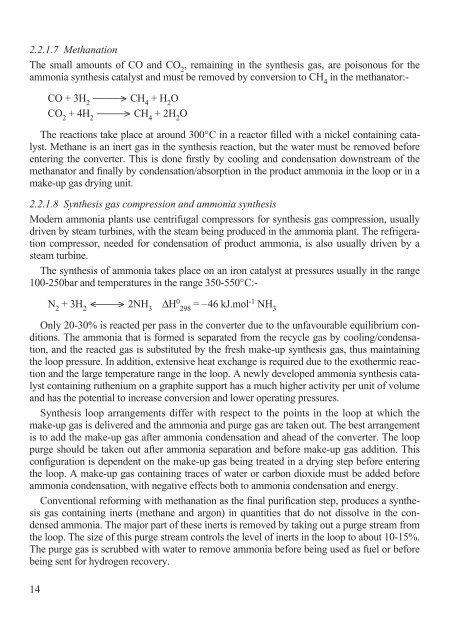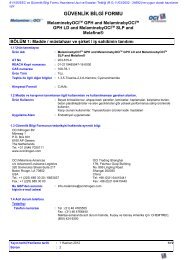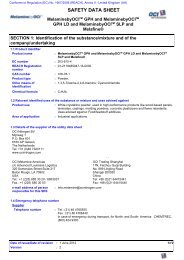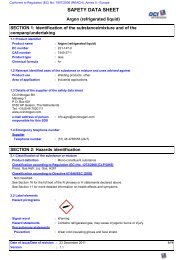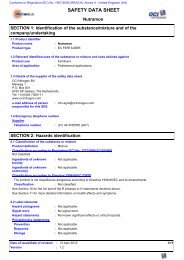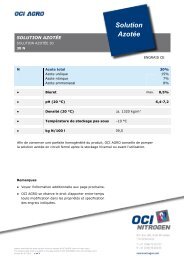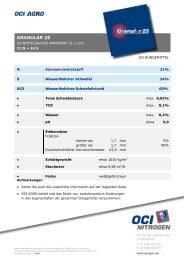PRODUCTION OF AMMONIA - OCI Nitrogen
PRODUCTION OF AMMONIA - OCI Nitrogen
PRODUCTION OF AMMONIA - OCI Nitrogen
You also want an ePaper? Increase the reach of your titles
YUMPU automatically turns print PDFs into web optimized ePapers that Google loves.
2.2.1.7 Methanation<br />
The small amounts of CO and CO 2 , remaining in the synthesis gas, are poisonous for the<br />
ammonia synthesis catalyst and must be removed by conversion to CH 4 in the methanator:-<br />
CO + 3H2 CH4 + H2O CO2 + 4H2 CH4 + 2H2O The reactions take place at around 300°C in a reactor filled with a nickel containing catalyst.<br />
Methane is an inert gas in the synthesis reaction, but the water must be removed before<br />
entering the converter. This is done firstly by cooling and condensation downstream of the<br />
methanator and finally by condensation/absorption in the product ammonia in the loop or in a<br />
make-up gas drying unit.<br />
2.2.1.8 Synthesis gas compression and ammonia synthesis<br />
Modern ammonia plants use centrifugal compressors for synthesis gas compression, usually<br />
driven by steam turbines, with the steam being produced in the ammonia plant. The refrigeration<br />
compressor, needed for condensation of product ammonia, is also usually driven by a<br />
steam turbine.<br />
The synthesis of ammonia takes place on an iron catalyst at pressures usually in the range<br />
100-250bar and temperatures in the range 350-550°C:-<br />
14<br />
N 2 + 3H 2 2NH 3 ΔH 0 298 = –46 kJ.mol-1 NH 3<br />
Only 20-30% is reacted per pass in the converter due to the unfavourable equilibrium conditions.<br />
The ammonia that is formed is separated from the recycle gas by cooling/condensation,<br />
and the reacted gas is substituted by the fresh make-up synthesis gas, thus maintaining<br />
the loop pressure. In addition, extensive heat exchange is required due to the exothermic reaction<br />
and the large temperature range in the loop. A newly developed ammonia synthesis catalyst<br />
containing ruthenium on a graphite support has a much higher activity per unit of volume<br />
and has the potential to increase conversion and lower operating pressures.<br />
Synthesis loop arrangements differ with respect to the points in the loop at which the<br />
make-up gas is delivered and the ammonia and purge gas are taken out. The best arrangement<br />
is to add the make-up gas after ammonia condensation and ahead of the converter. The loop<br />
purge should be taken out after ammonia separation and before make-up gas addition. This<br />
configuration is dependent on the make-up gas being treated in a drying step before entering<br />
the loop. A make-up gas containing traces of water or carbon dioxide must be added before<br />
ammonia condensation, with negative effects both to ammonia condensation and energy.<br />
Conventional reforming with methanation as the final purification step, produces a synthesis<br />
gas containing inerts (methane and argon) in quantities that do not dissolve in the condensed<br />
ammonia. The major part of these inerts is removed by taking out a purge stream from<br />
the loop. The size of this purge stream controls the level of inerts in the loop to about 10-15%.<br />
The purge gas is scrubbed with water to remove ammonia before being used as fuel or before<br />
being sent for hydrogen recovery.


